Key Insights
- The evolution of ATOM’s tokenomics kicked off in Q4, with inflation decreasing from 14% to 10% and the introduction of EIP-1559-style fee burning. These protocol changes triggered the AtomOne fork, after originating from the Tokenomics RFP and ATOM 2.0 paper.
- ATOM’s price and Cosmos Hub’s revenue increased 52% and 129% QoQ, respectively. Increased revenue helped to alleviate the economic effects of decreasing inflation.
- Daily active addresses and daily transactions increased 56% and 158% QoQ, respectively. The growth was partially driven by Inscriptions-related activity.
- Neutron and Stride’s TVLs grew 153% and 179% QoQ, respectively. They were the first two chains to be secured by Cosmos Hub’s Replicated Security and join the Atom Economic Zone.
- The Atom Alignment Treasury and Atom Accelerator DAO were funded for 2024, with plans to update governance/voting and to fund more RFPs, respectively.
Primer
Cosmos Hub (ATOM) is an individual appchain focused on interoperability and security. It is a Proof-of-Stake (PoS) sovereign blockchain with an account-based accounting model and no native smart contract functionality. Cosmos Hub pioneered technologies such as Cosmos SDK, CometBFT (Tendermint), ABCI, and IBC, which were later used by many Interchain networks. The Interchain consists of sovereign networks connected by the common interoperability protocol: IBC. The Interchain is also referred to as the Cosmos Ecosystem.
Cosmos Hub was launched in 2019, leveraging technologies built by the Interchain Foundation and Ignite (also known as Tendermint). Various groups continue to support the development of Cosmos Hub and the Cosmos tech stack, including the Interchain Foundation, Binary Builders, Atom Accelerator DAO, Informal Systems, Strangelove, and others. The Interchain is home to over 100 independent networks, each with its own unique supporting entities.
The Atom Economic Zone (AEZ) is an ATOM-aligned ecosystem set, which includes networks with various affiliations and integrations with the ATOM token. Networks that rent security from Cosmos Hub validators, i.e., Consumer Chains, are part of the AEZ. Replicated Security (formerly referred to as Interchain Security) refers to the sharing of the full Cosmos Hub validator set with another chain, permissioned by a governance vote. For a full primer on Cosmos Hub, refer to our Initiation of Coverage report.
Website / X (Twitter) / Telegram
Key Metrics
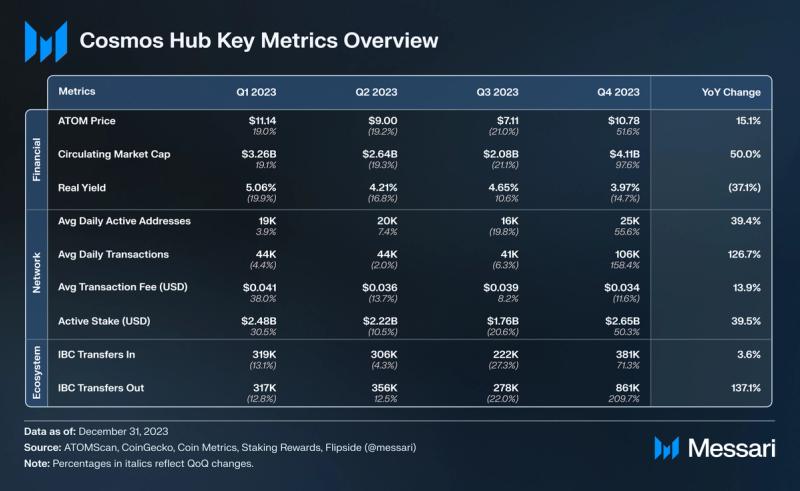
Financial Analysis
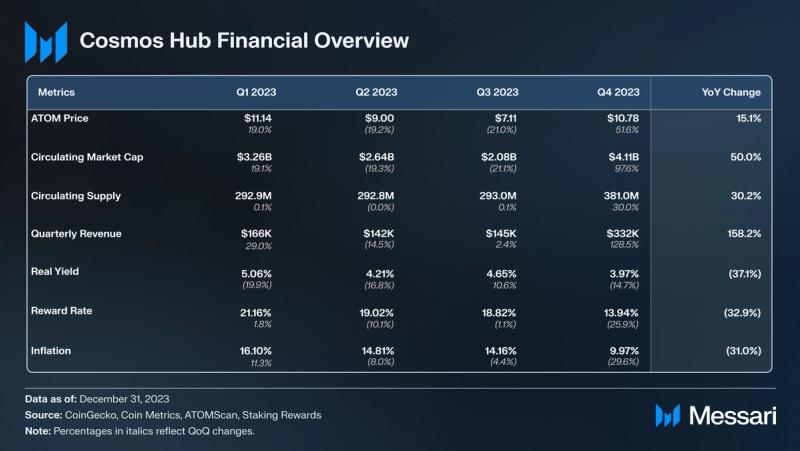
The total crypto market cap experienced a sharp increase in Q4, largely driven by anticipation surrounding spot BTC ETFs. ATOM’s circulating market cap increased 97.6% QoQ, outpacing the overall crypto market’s increase of 53.8%. Among network tokens, ATOM ranked 11th by market cap as of the end of Q4. ATOM’s price, however, only increased 51.6% QoQ. This difference between price and market price was due to the circulating supply increasing 30.0% QoQ.
ATOM, the native token of Cosmos Hub, is ICS-20 compatible. It allows users to transfer ATOM between chains connected through the IBC protocol. The asset serves the following functions:
- Transactions on Cosmos require a transaction fee settled in ATOM.
- Tokenholders can stake ATOM to operate a validator, securing the network and earning rewards.
- Tokenholders can delegate ATOM to an existing validator to help secure the network and earn a portion of the validator’s rewards.
- All staked and delegated ATOM can be used to vote in the network’s governance process.

Revenue is measured as total transaction fees. Cosmos Hub revenue increased 128.5% QoQ. On December 1, there was an activity spike that drove revenue up to $50,500; this was 17x the Q4 daily revenue of $3,000 when excluding the spike. The revenue spike was caused by Inscriptions-related activity.
Inscriptions are a transaction type popularized on Bitcoin in early 2023. They have popped up on almost every other large network since, even causing some outages due to the high activity volumes. Inscriptions are created by including arbitrary data in transactions, which makes them possible even on networks without native smart contract functionality.
Ignoring the Inscriptions spike, average daily fees still doubled in Q4. This was partially due to Proposal 843, which passed in November to raise the minimum gas prices for global fees. This doubled the cost of all transactions except for those proposed by Binance (due to Binance’s apparently modified mempool/Gaia software). The proposal was aimed at reducing the DDOS vulnerability of the network. Proposal 844 then cleared the bypass_min_fee_msg_types list to avoid peer-to-peer spam.
On November 20, the SEC again alleged ATOM to be a security — this time, in their case with Kraken. ATOM’s price briefly dipped and recovered within the week. The SEC has alleged many tokens to be securities at various times throughout 2023, including SOL, XRP, ADA, and more.
ATOM Tokenomics
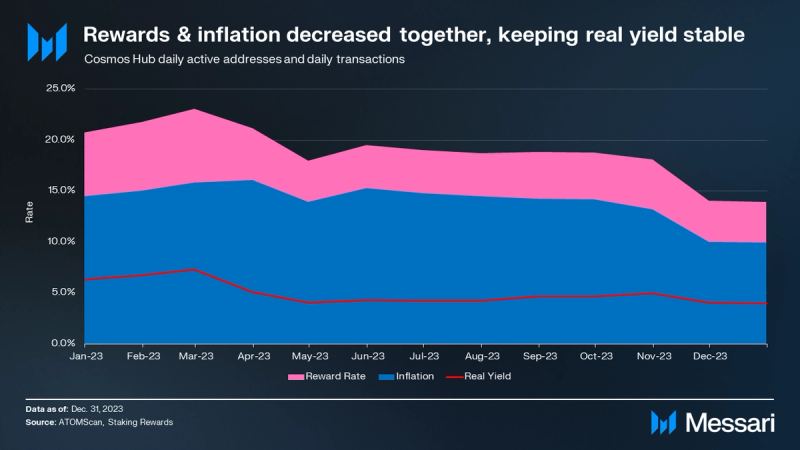
Cosmos Hub’s real yield was 4% as of the end of Q4. ATOM had a high inflationary rate of 10%, which nearly offset the 14% reward rate given to validators and delegators. Circulating supply is primarily affected by staking rewards for validators and delegators. Such a high reward and inflation rate placed a heavy tax on ATOM holders who do not participate in staking. As the inflation rate decreased 30% QoQ, the reward rate decreased by a similar amount, causing the real yield to decrease 15% QoQ.
Proposal 848 was passed in November, with the goal of reducing the max inflation rate from 20% to 10%. Once live, it immediately changed the actual ATOM inflation rate from 14% to 10%. This proposal was highly controversial, bringing in the highest turnout in Cosmos Hub Governance history. Proposal 868 aimed to take go further than Proposal 848 and reduce the InflationMin parameter to 0%, but it failed with 49% of votes against.
Blockworks Research conducted a study on ATOM. It found that ATOM was overpaying for security and suggested a transition to a set supply schedule. Nearly all 180 validators are break-even or profitable at 10% max inflation off of commission alone, and they have the option to increase their commission rate to help cover operational expenses.
Cosmos Proposal 826 passed in October, introducing a global minimum commission of 5% for validators. This initiative allows validators to generate revenue to reinvest in the security of the chain through improved operational capacity and better infrastructure. It was expected to reduce staking APR by 1%, which contributed to December’s MoM decrease in reward rate.
As of Q4, there are three forms of deflationary pressure on the ATOM token that contribute to deflation. Fee burning was added in Q4 via Proposal 842.
- Governance Burning – The Cosmos Hub features an onchain governance mechanism where ATOM tokenholders can vote and issue proposals, such as altering consensus parameters and community pool fund allocations. For a proposal to be submitted, it must have a minimum of 250 ATOM deposited to it from any tokenholder. If the proposal is vetoed, the deposit is burned.
- Slashing – Validator node rewards in ATOM can be slashed if a transaction is double-signed or a validator is offline for an extended period. Slashed rewards are subsequently burned.
- Fee Burning – an EIP-1559-style fee-burning mechanism was implemented by adopting Skip Protocol’s SDK. Base fees on transactions are burned due to this addition.
The rejected ATOM 2.0 proposal reimagined ATOM tokenomics. The goal of the overhaul was to drastically reduce ATOM’s issuance over several years before removing inflation altogether. Additionally, it aimed to improve capital efficiency and position ATOM as the Interchain reserve asset via liquid staking. Ultimately, these actions would drive value accrual to the ATOM token.
While the initial proposal was rejected (possibly due to its wide breadth and quick introduction), various components continued to be explored as individual proposals. Of note, two proposals (an increase in the treasury size and a liquid staking feature to improve ATOM capital efficiency) both passed in subsequent proposals following their initial introductions in ATOM 2.0. Other ATOM 2.0 features still in discussion around the community include permissionless shared security models and social coordination (i.e., governance) hubs for Interchain technologies (e.g., IBC, CosmWasm, etc.).
In Q4 2023, fee burning (similar to EIP-1559) was realized through Proposal 842, and improving the Cosmos Hub’s fee mechanism to minimize spam transactions was accomplished through Proposal 844.
In Q3, the Atom Accelerator DAO (AADAO) selected Blockworks Research, Binary Builders, and RMIT University to put forth a new tokenomics overhaul for ATOM — the Tokenomics RFP. The five proposals from the teams explore governance, liquid staking, treasuries, public funding, relationships within the Atom Economic Zone, and ATOM issuance.
Blockworks Research has proposed a change to fiscal policy. The proposal aims to transition from the current static 10% community pool tax to a more diversified tax approach. This new approach includes the following components:
- Vote Power Tax: Introduces a tax that discourages delegating to validators with higher Vote Power to address stake centralization issues.
- Dynamic Community Pool Tax: Proposes changing the community pool tax from a static percentage of inflation to a schedule that decreases over time until reaching a base tax of 5%.
Network Analysis

Daily active addresses and daily transactions increased 57% and 158% QoQ, respectively. Cosmos Hub continues to transition to the center of a new type of multichain ecosystem, one where Cosmos Hub serves as a security provider rather than just an interoperability hub.
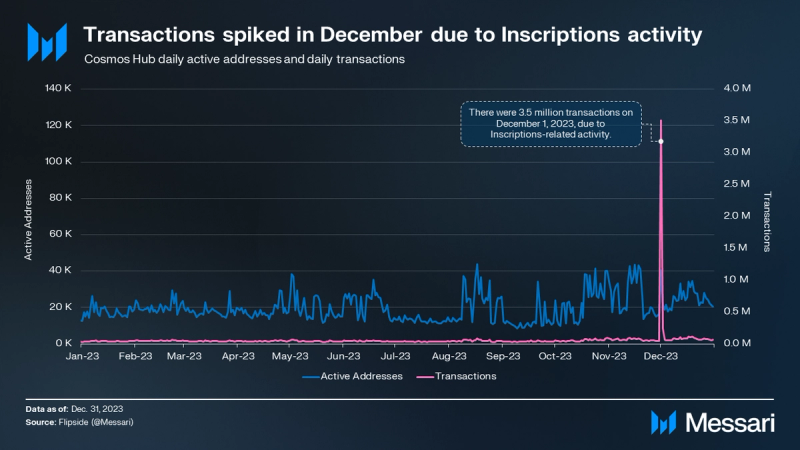
Inscriptions found their way onto Cosmos Hub, accounting for the massive spike of 3.5 million transactions on December 1, 2023. This activity spike came only days after the overwhelming rejection of Proposal 856, which sought to fund an Inscription protocol from the community spending pool. The proposal details the development of COSS (crc-20) to build an Inscription system on Cosmos Hub, integrating trading, minting, and other functions. Other Inscription protocols have been explored for Cosmos Hub since, including Asteroid. Asteroid, built by Delphi Labs, has so far seen sustained adoption and usage.
Inscriptions are a useful tool for storage on any network. Meta-protocols (i.e., fungible and non-fungible token standards), however, do not make sense on every network. Smart contract-enabled platforms such as Avalanche and Solana do not have much need for Inscriptions-based tokens, as all of their functions were already possible through smart contracts. However, networks like Bitcoin and Cosmos Hub do not have native smart contract functionality, making such meta-protocols an attractive option for building token standards. Cosmos Hub has a massive community, as a Schelling-point for the entire Interchain, which could translate to demand for alternative native assets. Additionally, Cosmos Hub has much cheaper and faster transactions than Bitcoin, also featuring IBC connectivity to more easily interop these new assets with other tools such as DeFi.
Staking and Decentralization

Cosmos Hub’s 67.6% staking rate is one of the higher rates among other L1 networks. Stakers consist of both validators and delegators. Users who stake ATOM and meet the system requirements can operate a validator to secure the network and earn rewards. Tokenholders can delegate a minimum of one ATOM to existing validators to receive a portion of the associated validator’s rewards. Delegators earn rewards relative to the number of tokens staked, although they’re charged a commission set by the individual validator.
Only the top 180 validators, ranked according to combined self-staked and delegated ATOM tokens, earn rewards. Of those validators, the top seven control 33% of the total stake, giving Cosmos Hub a Nakamoto coefficient of seven. In Q4, Proposal 861 sought to increase the active validator set from 180 to 190 but failed. It would have allowed over 700,000 ATOM, currently outside the active set, to participate in consensus.
Proposal 833 set the ValidatorLiquidStakingCap to 100% when it passed in October. This parameter represents the percentage cap on the portion of a validator’s stake that can be liquid. The previous 50% ValidatorLiquidStakingCap restricted liquid staking delegations to smaller validators. More details can be found in the Liquid Staking Module Forum Post.
Q4 also saw a discussion around the ATOM Wars, which could dramatically change the staking landscape. The idea behind the ATOM Wars is to give ATOM holders the ability to lock up staked tokens for up to one year in exchange for boosted decision power. This would directly affect distributions of protocol-owned liquidity (POL), with immediate economic outcomes.
Governance and Grants
Cosmos Hub uses a combination of offchain and onchain governance processes. Network improvement proposals and parameter changes are designed and discussed through offchain means, typically in the Cosmos governance forum. Anyone can propose a network or treasury management proposal and participate in the discussion. Users can also submit network change requests to the Cosmos Hub’s onchain governance system as official proposals. Once in the onchain governance system, ATOM stakers vote on whether to approve (and eventually execute) the proposed change. In Q4, 20 out of 24 governance proposals passed.
AADAO had its funding renewed through Proposal 865 after distributing seven batches of grants worth over $3.8 million from POL in 2023. The proposal funded AADAO with 975,811 ATOM ($3.8 million, as of writing) for 2024. AADAO led the Tokenomics RFP and allocated ~50% of the grant to ATOM zone buildout. In total, AADAO issued 39 grants in 2023. Several Transparency Reports were released throughout 2023 to detail the DAO’s functions, and the first Impact Report was released in Q4.
In 2024, AADAO will use 50% of its funds to support multiple new RFPs, after seeing the success of the Tokenomics RFP that was funded in 2023. The Tokenomics RFP has already led to tangible changes and improvements, as seen by the flurry of governance updates passed in Q4’23 alone. The remaining 50% of funds will go to public grants. Unlike in 2023, AADAO will be creating several new roles (i.e., marketing lead and grants lead) and will operate under an independent oversight committee. It will also create a new strategy committee to be in charge of RFP-based grants.
Binary Builders’ ATOM Alignment Treasury (AAT) aims to increase the decentralization of Cosmos Hub governance and voting. AAT’s support was formalized by Proposal 864 passing with 98% of votes. The formation of the AAT is to address two infrastructural problems: Liquidity deployment in the AEZ and alignment between Consumer Chains and the Hub.
Blockworks Research’s proposal has implications for governance in addition to the fiscal policy changes outlined in the ATOM Tokenomics section of the Financial Analysis.
- The Vote Power Tax discourages delegating to validators with higher Vote Power to address stake centralization issues.
- The Dynamic Liquid Staking Tax would be imposed on liquid stakers and would increase as the demand for liquid staking grows. It aims to find a natural equilibrium for liquid staking market penetration while generating tax revenue for Cosmos Hub.
- Proposal 833 removed the 25% liquid stake cap, allowing more participants to benefit from liquid staking. Cosmos Hub does not natively support liquid staking, but it is available through Stride, a network in the AEZ.
- Cubic Delegation has the potential to fix the centralization concerns with respect to onchain governance while ensuring quorum can still be met.
Network Updates
Several proposals in Q4 aimed to adjust throughput on the network through different means.
- Proposal 827 sought to reduce the maximum block size but failed.
- Proposal 845 passed, which will increase MaxBlockSize from 200 KB to 2 MB to avoid peer-to-peer spam, as described in the forum discussion for Proposal 843.
- Proposal 829 also passed and increased the gas limit by 150%.
Cosmos SDK and CometBFT both had software updates in Q4. One of the Cosmos SDK updates included adopting the Skip Block SDK, which is built on ABCI++. It includes the EIP-1559 fee market structure developed in collaboration with Osmosis Labs. The decision to implement the Skip Block SDK was passed through Proposal 842. Q4 also saw Gaia V13 activated and V14 passed, slated to be implemented next.
Proposal 839 passed to fund 2024 Cosmos Hub development by Informal Systems and Hypha Worker Co-op. The total budget is $5.7 million (to be held in 30% ATOM and 70% USDC), plus 100,000 ATOM (worth ~$1 million) in performance bonuses. This funding would replace both teams’ current funding from the Interchain Foundation and would have these teams be directly accountable to the community.
Jae Kwon, co-founder of the Cosmos Hub, detailed the AtomOne initiative. It is positioned as an alternative fork to the Cosmos Hub, Gaia, and was developed out of divergent views within the Cosmos community on key aspects such as mission, tokenomics, and security philosophy. The project also seeks to function as a political base, intending to address what it perceives as shortcomings in the existing governance and distribution within Gaia. This goal was particularly highlighted by the division in the community following Proposal 848 (halving the inflation rate). The vision of AtomOne includes running alongside Gaia as a minimal fork and acting as a base for a diverse ecosystem of specialized zones. It carries a focus on risk minimization and financial security for its hosted shards and connected networks.
The project will utilize ATOM1, the staking token of the AtomOne Hub, with 2/3 of the supply staked at all times. AtomOne proposes to realign the distribution of its token to better reflect security concerns and political alignment. AtomOne also introduces a higher threshold for consensus decisions, labeled the Constitutional Majority. It is initially set at 90%, aiming to achieve broader agreement in decision-making processes. The project also outlines plans for phases of development, starting with governance fixes and the launch of a governance-only chain. Eventually, the project will move towards implementing ICS1.5, developing scalable validator infrastructure, and finalizing the software.
IBC
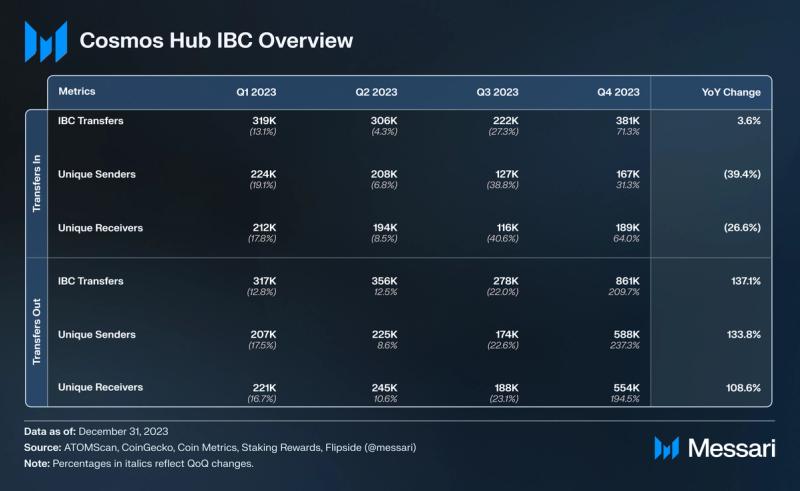
Cosmos Hub had 65 IBC peers and 422 IBC channels as of the end of Q4. “Peers” refers to the number of distinct counterparties of Cosmos Hub with established IBC connectors; “channels” refers to the total number of routes available for connecting to peers. Activity increased across the board for unique senders, unique receivers, and total transfers — both inbound and outbound. IBC transfers in and IBC transfers out increased 71% and 210% QoQ, respectively. Unique senders out had the largest QoQ increase, 237%.

For the most part, inbound and outbound transfers are tightly coupled. There are exceptions, such as a massive inbound spike in May 2023. In Q4, there were several spikes of outbound transfers that were not accompanied by equal-sized inbound traffic.
Proposal 862 passed, which will provide a fee-grant support system to cover gas fees for IBC relaying activities. It’s a temporary solution proposed by the Cosmos Hub relayers to prevent service degradation and ensure the continuity of efficient IBC operations. A multisig group will manage the distribution of the FeeGrants to vetted relayers with various onboarding requirements outlined in the respective forum post.
Ecosystem Analysis
Cosmos Hub is the center of many crypto communities. It serves as a Schelling point for Interchain ecosystems and modular builders in general. Some of this alignment from other communities is formal, and some is informal. In Q4, the DYM and SAGA airdrops both included ATOM stakers as eligible claimants, showing new builders still share an ideological alignment.
The Atom Economic Zone (AEZ) is an ATOM-aligned ecosystem set, which includes networks with various affiliations and integrations with the ATOM token. Several networks exist in the AEZ in varying capacities. Stride and Neutron receive Replicated Security, and Osmosis enables fees to be paid with ATOM. Other networks (such as Kujira or Agoric) rely on ATOM for much of their liquidity.
Replicated Security (formerly referred to as Interchain Security) is a form of shared security. Shared security refers to allowing the validators of one network to use stake on that chain to participate in the consensus of another network. This setup would allow smaller market cap networks to “rent” security from larger networks. Given that the Cosmos Hub has the largest market cap of all Interchain networks, it would be a prime candidate for renting out security. It is the AEZ strategy being explored most by the Cosmos Hub community and other Interchain networks. As of Q4, Neutron and Stride are the only chains utilizing Replicated Security.
However, Binary Builders’ “ATOM Alignment Treasury” (AAT) aims to make ATOM the default currency within the AEZ as well as to align staking and governance between Cosmos Hub and Consumer Chains. The team intends to use AAT funds for development efforts and bootstrapping liquidity across the AEZ. The AAT proposal, Proposal 864, passed with 98.1% approval in Q4.
Neutron
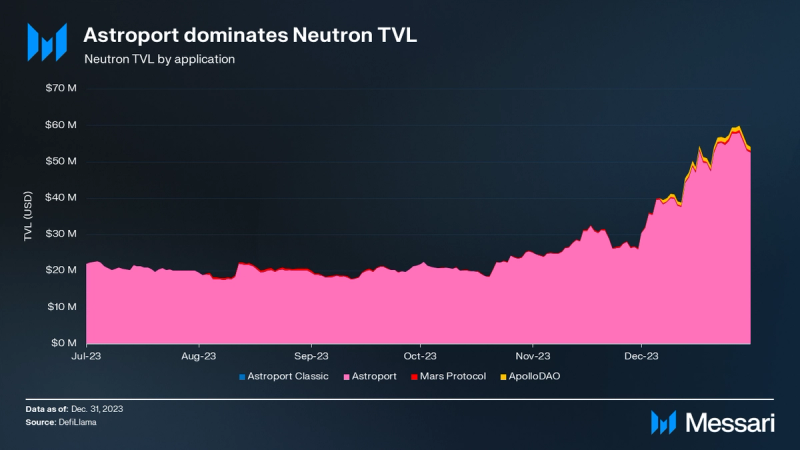
The passing of Proposal 792 saw Neutron become the first chain to leverage the Cosmos Hub’s validator set and security through Replicated Security. Neutron serves as a CosmWasm extension to Cosmos Hub and has effectively become Cosmos Hub’s DeFi center.
Neutron’s TVL increased 153% QoQ, almost entirely driven by Astroport. Astroport is an automated market maker (AMM) that also exists on other Interchain networks, such as Injective. Neutron is still a relatively new network, having only launched this year. Proposal 72 allocated Cosmos Hub funding for the development of Neutron, and Proposal 819 reallocated that funding directly to the Neutron Foundation. These funds may be used to further build out the ecosystem.
Proposal 835 authorized the Neutron DAO to transfer approximately 43 million unclaimed NTRN tokens from the airdrop to the Cosmos Hub community pool.
Stride

Stride implemented Replicated Security shortly after Neutron. This network enables liquid staking for various Interchain networks and assets. As ATOM is a core part of Stride’s activity, it made for an obvious early choice to adopt Cosmos Hub security. Liquid staking is a big market and a narrative across various other ecosystems. The Cosmos Hub benefits from having a liquid staking solution in the AEZ via Replicated Security as the utility is aligned by governance.
Stride’s TVL increased 179% QoQ and 1,396% YoY. Up until Q4, this TVL was almost entirely comprised of liquid-staked ATOM, with ATOM making up 80% or more of the total TVL (USD). This makeup changed in Q4 when OSMO began to grow and challenge ATOM for TVL dominance. ATOM’s TVL (USD) on Stride only grew by 64% QoQ. As of the end of Q4, ATOM and OSMO had 47% and 44% TVL dominance, respectively. Other tokens supported by Stride for liquid staking include STARS, EVMOS, JUNO, INJ, and more.
Stride-staked ATOM, stATOM, is integral for other AEZ networks as well. Cosmos Hub Proposal 805 (an amendment to Proposal 800 — Liquidity as a Service) will have AADAO deploy 450,000 ATOM to an ATOM/stATOM constant product pool on Astroport Neutron. On Osmosis, the ATOM/stATOM accounts for over $20 million in TVL.
A forum discussion arose in Q4 to explore the idea of converting the entirety of the STRD token supply into the ATOM token. If implemented, ATOM would become the sole governance token for the Stride protocol, effectively making the Stride blockchain a satellite chain of the Cosmos Hub. As such, the Cosmos Hub would potentially benefit from Stride Labs becoming a dedicated development unit, a new reward stream, and gaining full governance control over the Stride protocol.
Stride still receives competition from other liquid staking protocols. Proposal 853 allocated 600,000 of protocol-owned liquidity (POL) to pSTAKE to grow ATOM liquid staking. Once implemented, 15% of the fees acquired from the liquidity will go back to Cosmos Hub.
In return, pSTAKE will share 15% of liquid staking revenue with Cosmos Hub. The 600,000 ATOM will be liquid staked and deployed as Liquidity-as-a-Service (LaaS) on Astroport and Dexter.
Osmosis
The Osmosis AMM DEX has been deeply integrated with Cosmos Hub and ATOM since its inception. This integration deepened in Q4, when Proposal 810 on Cosmos Hub was passed to enshrine the Osmosis DEX for the purpose of flexible gas fee payments. The proposal allows for transaction fees on Cosmos Hub to be paid with any token, leveraging Osmosis to swap alternative tokens for ATOM.
As for integration on the Osmosis side, ATOM is an alternative gas token on the DEX. While ATOM is used for gas in certain cases, many of these examples are suspected to be bots due to their activity patterns.
In terms of liquidity, the very first pool on Osmosis, and still the largest by TVL as of Q4 2023, is the ATOM/OSMO pool. In Q4, Proposal 858 passed to allocate 900,000 ATOM to the ATOM/stATOM liquidity pool. This LP allocation aims to bolster the stability of the staked ATOM peg and protocol revenue.
The Future of the AEZ
There are several other versions of the shared security strategy in the Interchain. Mesh Security enables bi-directional security for networks with existing validator sets, and it focuses on stakers rather than validators. Mesh Security is being explored by both the Cosmos Hub and Osmosis. Another strategy, Babylon, aims to leverage Bitcoin for data availability of PoS chains and, in the process, mitigate security risks such as long-range attacks. In Q4, more information on Partial Set Security was shared.
Partial Set Security is similar to Replicated Security in that it’s organized through a governance proposal. However, Partial Set Security does not require every Cosmos Hub validator to participate. This opt-in form of shared security is more flexible and scalable, as validators can simply opt out of specific chains if their hardware requirements are strained. The potential development signals the continued intention of Cosmos Hub to only provide security for aligned networks rather than an agnostic approach such as Eigenlayer where any network can pay for security without requiring approval from the security provider. As of writing, Partial Set Security is still in development.
More chains may soon join the AEZ in varying capacities. Composable Finance submitted a proposal to join the AEZ and receive Replicated Security from Cosmos Hub, just as Stride and Neutron did. With Neutron as a programmability and DeFi hub and Stride as a liquid staking solution, Composable has proposed to become a rollup settlement hub, as it is connected to other multichain ecosystems.
Joining the AEZ is intended to be more of a partnership than a transaction, as member networks aim to have symbiotic relationships with each other and receive benefits from Cosmos Hub, such as distributions of POL. “ATOM alignment” and a role in the AEZ can be more subjective when they’re not based on renting security. Some community members argue that networks such as Agoric and Kujira are already part of the AEZ due to their ecosystems’ liquidity dependence on ATOM. Formal classifications aside, Cosmos Hub’s role currently exists as both a security provider and a liquidity provider to its broader ecosystem.
Closing Summary
Cosmos Hub continued its evolution in Q4. In 2023, Cosmos Hub became a security provider through Replicated Security and began to revamp its tokenomics (as first envisioned by ATOM 2.0 and later the Tokenomics RFP). Various governance proposals in Q4 introduced lower inflation parameters, EIP-1559-style fee burning, and spam prevention fee adjustments.
Revenue increased 129% QoQ, which helped to smooth the new inflationary policy. Throughout the quarter, revenue sources continued to develop, with new streams continuing to be ideated upon by the community. Inscriptions may actually be here to stay on Cosmos Hub, unlike with most other networks which only saw brief activity spikes; Partial Set Security was introduced as an alternative to Replicated Security for Atom Economic Zone (AEZ) networks; and liquidity-as-a-service was further explored through new distributions of Cosmos Hub’s protocol-owned liquidity (POL) such as pSTAKE.




















